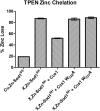The yeast copper chaperone for copper-zinc superoxide dismutase (CCS1) is a multifunctional chaperone promoting all levels of SOD1 maturation
- PMID: 30530491
- PMCID: PMC6369272
- DOI: 10.1074/jbc.RA118.005283
The yeast copper chaperone for copper-zinc superoxide dismutase (CCS1) is a multifunctional chaperone promoting all levels of SOD1 maturation
Abstract
Copper (Cu) is essential for the survival of aerobic organisms through its interaction with molecular oxygen (O2). However, Cu's chemical properties also make it toxic, requiring specific cellular mechanisms for Cu uptake and handling, mediated by Cu chaperones. CCS1, the budding yeast (S. cerevisiae) Cu chaperone for Cu-zinc (Zn) superoxide dismutase (SOD1) activates by directly promoting both Cu delivery and disulfide formation in SOD1. The complete mechanistic details of this transaction along with recently proposed molecular chaperone-like functions for CCS1 remain undefined. Here, we present combined structural, spectroscopic, kinetic, and thermodynamic data that suggest a multifunctional chaperoning role(s) for CCS1 during SOD1 activation. We observed that CCS1 preferentially binds a completely immature form of SOD1 and that the SOD1·CCS1 interaction promotes high-affinity Zn(II) binding in SOD1. Conserved aromatic residues within the CCS1 C-terminal domain are integral in these processes. Previously, we have shown that CCS1 delivers Cu(I) to an entry site at the SOD1·CCS1 interface upon binding. We show here that Cu(I) is transferred from CCS1 to the entry site and then to the SOD1 active site by a thermodynamically driven affinity gradient. We also noted that efficient transfer from the entry site to the active site is entirely dependent upon the oxidation of the conserved intrasubunit disulfide bond in SOD1. Our results herein provide a solid foundation for proposing a complete molecular mechanism for CCS1 activity and reclassification as a first-of-its-kind "dual chaperone."
Keywords: CCS1; chaperone; copper transport; copper-zinc superoxide dismutase (SOD1); dual chaperone; enzyme maturation; metal ion-protein interaction; metallo-chaperone; metallo-protein; multifunctional enzyme; oxidative stress; post-translational modification (PTM); protein complex; superoxide dismutase (SOD).
© 2019 Boyd et al.
Conflict of interest statement
The authors declare that they have no conflicts of interest with the contents of this article
Figures






References
-
- Dancis A., Haile D., Yuan D. S., and Klausner R. D. (1994) The Saccharomyces cerevisiae copper transport protein (Ctr1p): biochemical characterization, regulation by copper, and physiologic role in copper uptake. J. Biol. Chem. 269, 25660–25667 - PubMed
Publication types
MeSH terms
Substances
Grants and funding
LinkOut - more resources
Full Text Sources
Molecular Biology Databases
Miscellaneous

